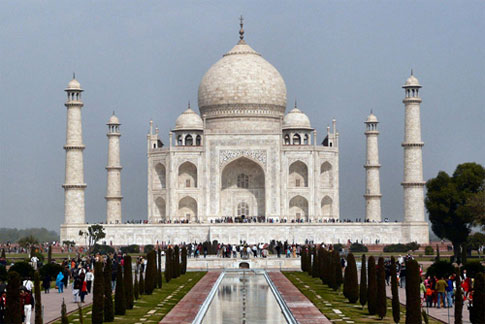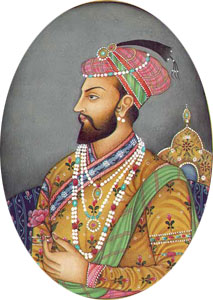Shah Jahan, a tale of romance and art
By Amal Hewavissenti
Emperor Shah Jahan's reign registered a memorable landmark in the
history of Moghul empire. It is believed that the royal coffers were
full to the brim with priceless articles and wealth and incredibly
charming edifices and mini-palaces were raised in the cities of Lahore,
Delhi and Agra.
Young Shah Jahan had a tendency for vandalism and depravity which
appeared inherent in him and ran counter to his subsequent sobriety and
composed nature.
|

Taj Mahal |
However, this composed nature that came over him in the latter period
of his life was largely owing to the bereavement from his "Soul partner"
Mumtaz Begam Mahal - an inexpressibly poignant theme of romance in
history.
Surrounded
If we are to count on the records of Burnnier, a traveller, Shah
Jahan brutally attacked the city of Hugely which lay surrounded by a
moat by using a large body of troops (150,000)! In the course of the
attack which lasted three months, the troops removed the water from the
moat, submerged a ship with 2,000 women and children in flight and took
about 4,000 people to Agra as prisoners of war.
After indescribable torture, some of the prisoners of war were
forcibly converted to his faith and some others were made to be trampled
to death by elephants.
Here, more people died of fever and famine according as Burnnier's
records claim. Burnnier further records that the child captives became
tragic victims at the hands of soldiers and while some others were given
rigid duties at the royal palace. No other group of people to have
undergone greater level of brutality has not been recorded in recent
history.
Jahangir's death virtually left the throne for "Bhurum" (Shah Jahan),
the successor who married Princess Mumtaz Begam Mahal the daughter of
Azaap Khan. History reports how a royal conspiracy was in operation to
overthrow Shah Jahan but Azaap Khan brought him back from Deccan to
declare him the legal emperor. Shah Jahan's younger "Sharier" was proved
to be the chief conspirator.
Finally, Shah Jahan brutally blinded his younger brother after
imprisonment and destroyed all who were the masterminds behind the plot
to oust the legal emperor. However, his matchless love for Mumtaz was
totally amazing - a love which contrasted visibly from the conventional
emotional relationship between a king and a queen. The breath takingly
beautiful dome of Taj Mahal (symbolic of eternal love) was masterminded
by Shah Jahan in loving memory of his favourite queen Mumtaz Mahal who
died prematurely.
Mumtaz was fortunate enough to attract the infallible love and
affection undivided from the emperor. Tragic enough, Mumtaz died on
delivering a baby. Although the Moghul princes were amply blessed with
the privilege of polygamy, Shah Jahan was ever immutable in his
determination to reject remarriage.
Frustration
Ultimately emperor fell prey to an utter frustration and he is said
to have locked himself up in a dark room whereby his hair had absolutely
turned grey. There is an interesting episode within this prolonged
ordeal in the dark room. Once a lady from his concubine (named Thuldaazi
) attempted to approach the emperor, a total recluse but the grief
stricken lover is quoted to have said,
"Go you lady! away! In the dead of night you try to plaque me -
fatigue me with your carnal urges. My life is long gone and I see no
difference between life and death now. I feel pity on you but you can
never be Mumtaz.
|

Shah Jahan |
This door I will open after seven days. Do leave me alone...."
However, ruthless and tough minded Shah Jahan might have been these
words are redolent of his undisguised love for the dead queen.
Mentally, paralysed by the untimely death of his cherished wife, the
emperor was firmly bent on erecting the greatest wonder of India, on the
banks of river Jumma. It was Taj Mahal.
The abrupt, severe melancholia which came over the emperor on the
death of Mumtaz Mahal explicitly shows how far he had loved her and how
much emotionally dependent he was on his love for her.
It is said that the emperor was highly impressed by the exceptional
poetic genius of Mumtaz who often wrote fragments of poetry on love
during their walks in the garden.
However, as a clear offshoot of a heavy blanket of depression, Shah
Jahan fell sick and a greater level of political instability pervaded in
the empire as a battle of succession among his sons ensued. The emperor
had established his favourite son Darashiko in Panjab as the regent but
his youngest son Auranzeb, with inborn depravity and brutality rose
against him to capture the throne.
Here, the battle was between mutually contrastive brothers namely
Darashiko who was considered to be generous, sympathetic and charismatic
and Auranzeb who was absolutely marked with ruthless, depravity and
craft.
Instability
This political instability originated with the final collapse of the
emperor as a sick person.
The decisive battle between the two forces finally left Auranzeb
victorious who came to Agra and appropriated all the wealth in the state
coffers.
Moreover, the new emperor employed all plans to capture his brother
and finally assigned a slave called Nazaar the task of bringing
Darashiko's head back to Auranzeb's Palace.
Nazaar beheaded Darashiko after a long chase and Auranzeb ordered it
to be put into a bowl of water. Provocated by this inhuman slaughter,
people around the palace stoned Nazar to death and labelled him a dead
traitor.
Thus Auranzeb adopted a dictatorial attitude within the empire and
ruined virtually every force that thwarted his imperial intentions.
Auranzeb's barbarism was made public when he directed his ill will
towards his old fragile father (Shah Jahan). Shah Jahan was imprisoned
in the "Red Fort" from where he could look at the matchless monument of
Taj Mahal from a small window. He was nursed by his loving daughter
"Jahanara" until he breathed his last in the Red Fort with his eyes
fixed on Taj Mahal.
The beautiful Taj Mahal majestically towering skyward takes the
visitor back to a world of unfailing love, hatred, depravity and tragedy
that once landed India into an upheaval during Moghul empire. |

